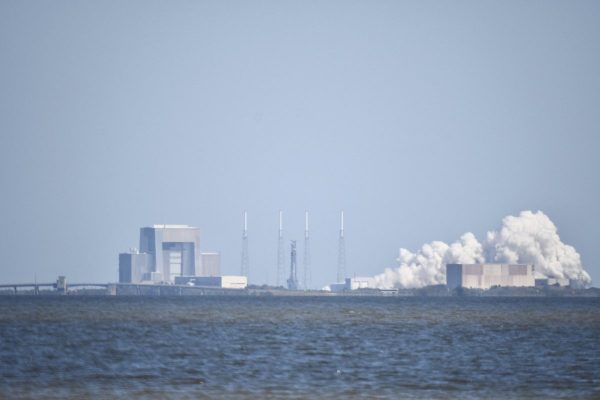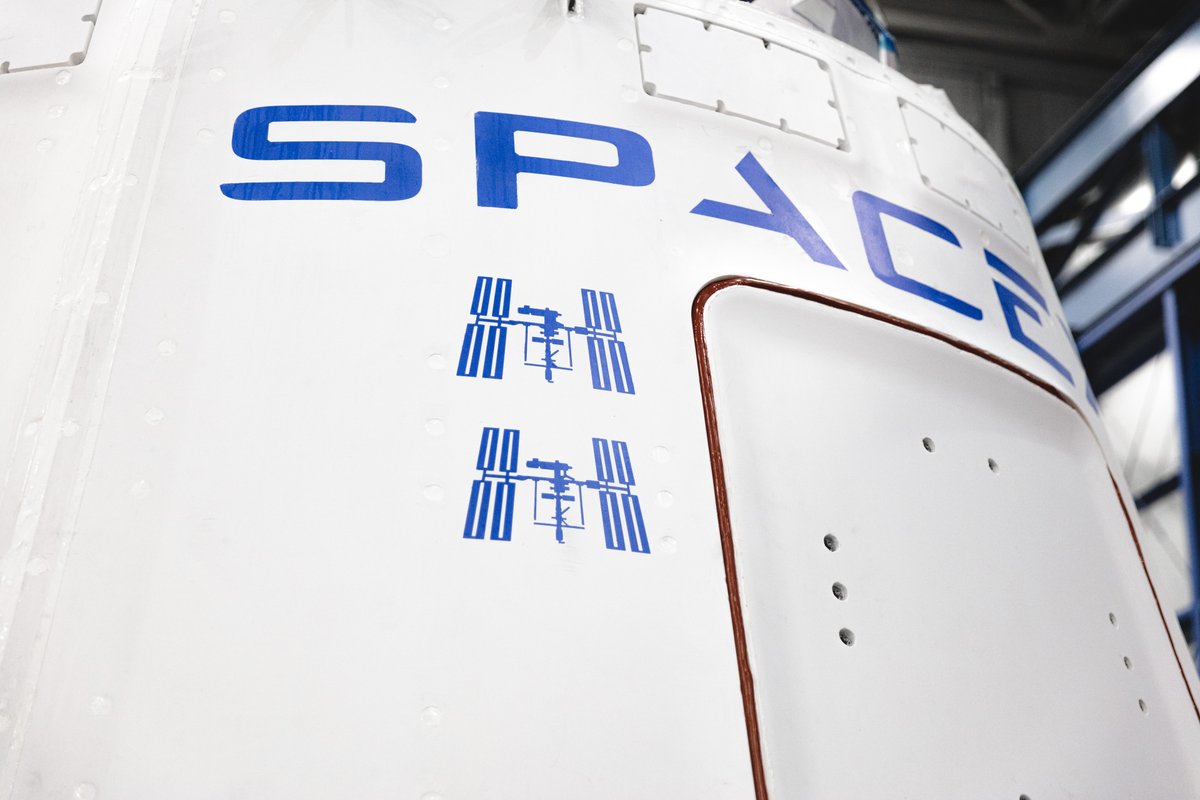SpaceX test-fires rocket, preps for final flight of first-generation Dragon capsule – Spaceflight Now

The Falcon 9 booster for SpaceX’s next mission fired up briefly on a Cape Canaveral launch pad Sunday in a routine pre-flight test before a scheduled launch Friday night to kick off the final flight of the first version of the company’s Dragon cargo capsule to the International Space Station.
Nine Merlin 1D main engines at the base of the Falcon 9 booster fired up at 11 a.m. EST (1600 GMT) Sunday at Cape Canaveral’s Complex 40 launch pad. Hold-down clamps kept the rocket firmly on the ground as the engines throttled up to produce 1.7 million pounds of thrust for several seconds.
The test-firing is a customary step in SpaceX’s launch campaigns, providing an opportunity to check the readiness of the Falcon launcher and exercise the SpaceX launch team.
SpaceX drained the rocket of its kerosene and liquid oxygen propellants after Sunday’s test-firing, and teams planned to lower the Falcon 9 horizontal and return it to a nearby hangar for attachment of a Dragon cargo capsule this week.
The fully assembled launch vehicle will stand 213 feet (65 meters) tall with the Dragon spacecraft on top.
Liftoff is scheduled for 11:49 p.m. EST Friday (0449 GMT Saturday) from pad 40 on SpaceX’s fifth mission of the year, and the 20th operational Dragon resupply mission to the space station since 2012. The first stage booster is expected to land back at Cape Canaveral Air Force Station around eight minutes after liftoff.
NASA says the Dragon capsule will deliver more than 5,600 pounds of cargo to the space station. Assuming it launches Friday night, the supply ship is scheduled to arrive at the orbiting research complex early Monday, March 9.
The mission will mark the final flight of the first version of SpaceX’s Dragon spacecraft, which debuted in 2010 with a test flight in low Earth orbit. The Dragon capsule accomplished its first trip to the International Space Station in May 2012 on a second demonstration mission under NASA’s Commercial Orbital Transportation Services, or COTS, program.
Through the COTS program, NASA contributed $396 million toward the development of the Dragon spacecraft and Falcon 9 launcher in a public-private partnership with SpaceX. NASA says SpaceX contributed roughly $450 million to the effort.
By any measure, the investment paid off.
SpaceX received a NASA Commercial Resupply Services, or CRS, contract in 2008 to resupply the space station on a series of Dragon missions, and the company won a NASA competition in 2014 to develop an upgraded Dragon spacecraft to ferry astronauts to and from the station.
The commercial cargo and crew transportation agreements were designed to give NASA a way to get astronauts, experiments, space parts and other equipment to the space station after the retirement of the space shuttle in 2011.
Northrop Grumman is NASA’s other commercial cargo transportation provider, and Boeing joined SpaceX as the other contractor the commercial crew program.
Although NASA was the anchor customer for the Falcon 9 launcher, SpaceX has won billions of dollars in launch contracts with commercial satellite companies and the U.S. military over the last decade.
The Falcon 9’s success in the global launch market have returned many commercial satellite launches to the United States after years of domination by European and Russian rockets. And the U.S. military can now procure launches from two companies — SpaceX and United Launch Alliance — offering the Pentagon a competitive market to launch military satellites after awarding the bulk of its contracts to ULA following that company’s formation in 2006.
SpaceX went on to develop the Falcon Heavy, comprised of three Falcon 9 first stage boosters bolted together. And SpaceX has recovered Falcon rocket boosters 49 times since 2015, allowing the company to refurbish and reuse the hardware, and reduce prices.
The Falcon 9 booster assigned to Friday night’s launch previously launched Dec. 5 on SpaceX’s previous Dragon cargo mission, then landed on the company’s drone ship in the Atlantic Ocean.
SpaceX began regular cargo transportation flights to the space station in October 2012. Since the initial contract award in 2008, NASA has extended the CRS agreement with SpaceX from 12 missions to 20 flights, boosting its value to more than $3 billion.
The Dragon capsule itself has performed well on all its missions, successfully reaching the space station and returning to Earth on all but one flight. A Falcon 9 rocket failed during launch on a resupply flight in June 2015, destroying a Dragon spacecraft and its cargo load.
SpaceX launched its last new first-generation Dragon spacecraft in August 2017. Since then, the company has reused Dragon vehicles that were refurbished after splashing down in the Pacific Ocean.
The Dragon spacecraft being readied for Friday’s launch — designed CRS-20, or SpaceX-20 — previously flew to the space station twice on the CRS-10 and CRS-16 missions in February 2017 and December 2018, according to SpaceX.

NASA awarded a second Commercial Resupply Services contract to SpaceX in 2016. Orbital ATK — now part of Northrop Grumman — and Sierra Nevada Corp. also received CRS-2 contracts to resupply the space station through the mid-2020s.
SpaceX plans to use a cargo-carrying variant of its next-generation Dragon 2 spacecraft for the CRS-2 missions. The Dragon 2’s human-rated configuration, known as the Crew Dragon, completed an unpiloted test flight to the space station in March 2019, and could fly with astronauts for the first time as soon as May.
The Dragon 2’s first regular cargo mission is scheduled for launch in October.
Northrop Grumman launched its first CRS-2 mission using upgraded versions of its Antares rocket and Cygnus supply ship last November, and Sierra Nevada’s Dream Chaser space plane is scheduled to fly to the space station for the first time in 2021.
The Dragon 2 spacecraft has a different aerodynamic shape than the first-generation Dragon. It can also dock automatically with the space station, without requiring station crews to capture it with the research lab’s Canadian-built robotic arm.
The cargo version of Dragon 2 will launch without seats, cockpit controls and other life support systems required to sustain astronauts in space. The cargo version will also launch without the SuperDraco escape thrusters fitted to human-rated Dragon capsules.
While SpaceX and NASA do not initially plan to reuse Dragon 2 capsules for crew missions, the cargo variant will be qualified to fly to the space station and back to Earth up to five times, officials said. The first-generation Dragon capsule was capped at three missions.
Beginning with the CRS-21 mission late this year, the new Dragon 2 cargo capsules will splash down under parachutes in the Atlantic Ocean east of Florida, rather than the current recovery zone in the Pacific Ocean west of Baja California, SpaceX officials said last year.
SpaceX will refurbish the Dragon cargo vehicles at Cape Canaveral, rather than at the company’s facilities in Texas and California, officials said.

SpaceX officials said last year that Dragon 2 cargo missions will launch from pad 39A at the Kennedy Space Center, the same facility that will host crew launches. That will allow ground teams to load last-minute supplies and time-sensitive experiments into the capsule using the access arm built for astronauts.
SpaceX currently uses a mobile clean room to install the final cargo into the Dragon spacecraft at pad 40.
The Dragon 2 will be able to carry heavier cargo loads to the space station. But the Dragon 2’s primary arrival mode, using docking rather than capture and berthing with the robotic arm, comes with a limitation.
The hatches through the space station’s docking ports are narrower than the passageways through the berthing ports currently used by Dragon cargo vehicles.
Northrop Grumman’s Cygnus supply ship and Sierra Nevada’s Dream Chaser space plane are designed to berth to the space station, offering transportation for bulkier items.
Email the author.
Follow Stephen Clark on Twitter: @StephenClark1.






